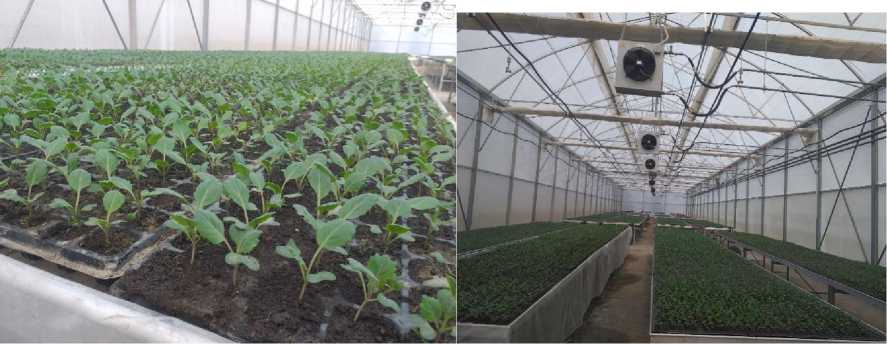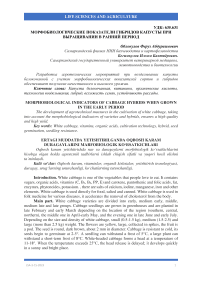Morphobiological indicators of cabbage hybrids when grown in the early period
Автор: Oblokulov Feruz Abduraimovich, Begimkulov Ilkhom Bakhtiorovich
Журнал: Life Sciences and Agriculture.
Статья в выпуске: 3 (15), 2023 года.
Бесплатный доступ
The development of agrotechnical measures in the cultivation of white cabbage, taking into account the morphobiological indicators of varieties and hybrids, ensures a high-quality and high yield.
White cabbage, vitamins, organic acids, cultivation technology, hybrid, seed germination, seedling resistance
Короткий адрес: https://sciup.org/14130666
IDR: 14130666 | УДК: 635.631
Текст научной статьи Morphobiological indicators of cabbage hybrids when grown in the early period
Introduction. White cabbage is one of the vegetables that people love to eat. It contains sugars, organic acids, vitamins (C, B 1 , B 2 , PP, E) and carotene, pantothenic and folic acids, fat, enzymes, phytoncides, potassium. , there are salts of calcium, iodine, manganese, iron and other elements. White cabbage is used directly for food, salted and canned. White cabbage is used in folk medicine for various diseases, it accelerates the removal of cholesterol from the body.
Main part. White cabbage varieties are divided into early, medium early, middle, medium late and late groups. Cabbage seedlings are grown in greenhouses and are planted in late February and early March depending on the location of the region (southern, central, northern), the middle one in April-early May, and the evening one in late June and early July. Depending on the size and density of white cabbage, small (0.5-1.5 kg), medium (1.5-2.5) and large (more than 2.5 kg) weight. The flowers are yellow, large, collected in spikes, the fruit is a pod. The seed is round, dark brown, about 2 mm in diameter. Cabbage is resistant to cold, its seeds begin to germinate at 2-5°. A seedling can withstand a frost of 5°C, a large plant can withstand a short-term frost of 8°C. White-headed cabbage forms a head at a temperature of 11-18°. When the temperature exceeds 25°C, the head release is delayed; it develops quickly in a sunny and bright place.
Materials and methods: Our research was conducted in the experimental fields of the Samarkand scientific experimental station of the scientific research institute of vegetable crops and potatoes. The objects for our field experiments are white cabbage Nazami F1, Farova F1. N-31 F1 hybrids served.
Field experiments and laboratory analyzes are conducted on the basis of methodological manuals developed by scientists of the Scientific Research Institute of Vegetables, Water melon and Potatoes (2023). The following observations, measurements and calculations were carried out in the research:
Duration of the growing season and biometric indicators and productivity of plants - the quality of the seeds was evaluated based on the requirements of the State Standards for the seeds of agricultural crops;
-
- the results obtained from the research were processed statistically according to B.A. Dospekhov (1979).
Results and their analysis: It should be noted that among the studied cabbage hybrids, in terms of the indicator of seed germination, it was observed in the Farova hybrid, and in the rest of the hybrids, the seed germination was not less than 99%. It was observed that the Farova hybrid had a high 98.5% of the field fertility of seeds. The field fertility of N-31 hybrid seeds was 98.2%.
Table - 1.
Analysis of laboratory and field germination of white cabbage seeds and germination of seedlings
|
№ |
Hybrid name |
Laboratory germination of seeds |
Field germination of seeds |
Resilience of seedlings |
|
1 |
Farova |
100 |
98.5 |
98 |
|
2 |
Nazomi |
99.5 |
98.0 |
96.5 |
|
3 |
N-31 |
99.5 |
98.2 |
97.6 |
After transplanting the seedlings of the hybrids grown in the greenhouse to the field, the analysis of the indicators of seedling resistance showed that in the studied hybrids this indicator was 98% for Farova, 96.5% for Nazomi, and 97.6% for N-31. From this we can conclude that the highest indicator (98%) was observed when we planted the seedlings of Farova hybrids in the field. This phenomenon can be explained by the fact that the phenological phases of Farova hybrid seedlings are relatively uniform. Because the process of formation of 6-7 chinbars in these hybrid seedlings was higher than 95% in 37-38 days.
Table - 2.
The results of growing white cabbage seedlings in a greenhouse
|
№ |
Hybrid name |
Planting period |
Germination |
Leaf formation |
Forming 3-4 leaves |
Forming 6-7 leaves |
Seedling maturity, days |
|
1 |
Farova |
05.02.2023 |
10.04.2023 |
17.02.2023 |
26.02.2023 |
15.03.2023 |
38 |
|
2 |
Nazomi |
05.02.2023 |
09.04.2023 |
15.02.2023 |
25.02.2023 |
13.03.2023 |
36 |
|
3 |
N-31 |
05.02.2023 |
11.04.2023 |
18.02.2023 |
02.03.2023 |
19.03.2023 |
42 |

Photo 1. Cabbage seedlings in the greenhouse that have produced 3-4 leaves.
From the results of growing white cabbage seedlings in a greenhouse, it can be concluded that, among the hybrids, seedlings of the Nazomi hybrid produced 6-7 leaves in 36 days and were ready for planting in the field, while in the Farova hybrid, this indicator took 38 days. In the 31st hybrid, it was 42 days.
Table - 3.The results of yield white cabbage seedlings in a greenhouse
|
№ |
Hybrid name |
The yield of hybrids is t/ha |
Product yield % |
|
1 |
Farova |
66.3 |
94.5 |
|
2 |
Nazomi |
62.4 |
95.0 |
|
3 |
N-31 |
68.2 |
96.2 |
Conclusion. It can be concluded from the yield indicators of white cabbage hybrids studied in the experiment that high and quality harvest was ensured in all hybrids. Farova yielded 66.3 t/ha, Nazomi 62.4 t/ha, and N-31 68.2 t/ha. Our N-31 hybrid showed a high (96.2%) indicator according to this indicator, when the yield of the hybrids was analyzed.
Список литературы Morphobiological indicators of cabbage hybrids when grown in the early period
- Amirov B.M., Lukyanets V.N., Kiseleva N.A. Guidelines for varieties of white cabbage. -Alma-ata. Kaynar, 2005
- Kitaeva E.I., Orlova V.I. White cabbage.-Moscow. Rosselkhozizdat. 1980.
- Ostonakulov T., Zuev V., Kadirkhojaev O. Fruit growing and vegetable growing. Tashkent. 2018.
- State register of agricultural crops recommended for planting in the territory of the Republic of Uzbekistan. Tashkent. 2021.


